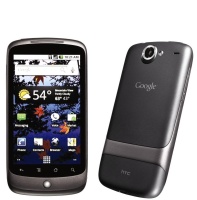Google announces Nexus One smartphone

![]() Google's new Nexus One "superphone".
Google's new Nexus One "superphone".
Source: Google
On Tuesday, at the company's headquarters in Mountain View, California, Google introduced its first own-brand smartphone, the Nexus One. Since information about the Nexus had repeatedly appeared in the IT media in December, probably not entirely without Google's assistance, this didn't come as a major surprise. The same also applies to many of the Nexus One's features. The smartphone weighs 130 grams and is, like Google's first G1 phone, manufactured by the Taiwanese vendor HTC.
For the first time, HTC has equipped a smartphone with an AMOLED display. Previously only used by Samsung, this display type provides vibrant colours and high contrast, but is likely to become illegible in direct sunlight. The 3.7-inch capacitive touch screen offers a resolution of 480 by 800 pixels. High performance computing is provided by Qualcomm's Snapdragon chip-set with a processor core clock speed of one Gigahertz. This is supported by a high performance multimedia signal processor as well as 256 MB of RAM and 512 MB of Flash memory. Storage is expandable up to 32 GBs via a micro SDHC slot, and Google plans to ship a 4 GB card with the phone .
The Nexus One also features a 5 megapixel camera with autofocus lens and LED flash, Wi-Fi, Bluetooth 2.1 with A2DP stereo audio profile support, an AGPS receiver for navigation and a compass. The quadband GSM device works in almost any GSM network worldwide and – apart from some American networks such as AT&T, which don't have the 1900 MHz band – in most UMTS networks; UMTS connections in Europe shouldn't be a problem. The phone offers fast data transfer rates in GSM networks via EDGE, and in UMTS networks via HSPA, reaching downlink rates of up to 7.2 Mb/s and gross uplink rates of up to 2 Mb/s. Voice quality is to be enhanced by an integrated noise cancellation feature which uses a second microphone to record and block ambient sound.
The Nexus One runs the latest version 2.1 of Android, which offers such functions as Google Maps navigation and voice-activated searching that are already familiar from Motorola's Milestone, but also features enhanced multimedia functionality, five home screens with an overview page and animated backgrounds. Furthermore, Google plans to provide additional applications such as Google Earth, although the Nexus One does not recognise multi-touch gestures for zooming into maps and web pages.
Interestingly, the mobile phone is quite modestly priced for a top-range device: Google offers the Nexus One for around $530 unlocked and without a contract, but will initially only market the smartphone in the US, the UK, in Singapore and in Hong Kong. T-Mobile USA is offering a contract version of the phone from $180, while other network operators such as Vodafone in Europe and Verizon in the US are scheduled to follow in spring. Whether or when the smartphone will become available in Germany, however, has not been disclosed by the vendor.
It remains to be seen whether this HTC built Android smartphone can utilise the added speed offered by the 1 GHz chip in practical applications. While some members of the gadget community have voiced disappointment because Google apparently hasn't reinvented the wheel, the vendor's competition will do well to watch out. With this solidly built top-range device, Google has presented itself as a new player in this high-end segment.
Where there is a challenger, there is also a champion. In the premier league of smartphones this champion is Apple, whose iPhone has shown the competition how things are done for almost three years. Not all the mobile makers have followed the clear signal from Cupertino yet – be it because they can't or because they don't want to. This leaves room for ambitious new market entrants. When such entrants take the stage equipped with a fat wallet and the necessary know-how, they are a force to be reckoned with – particularly for giants Nokia and Microsoft, who have not yet fully come to grips with the new mobility.
Google has both the know-how and the fat wallet available, which gives the vendor very good chances for firmly instituting its already ubiquitous internet brand in the mobile telephony sector. Google has already establish a presence, albeit an indirect one, with the emerging Android operating system. Selling its own-brand mobile phone that fully utilises the features of the Android operating system, and is available contract-free, enables Google to take a confident step into a new terrain. The vendor has coined the slogan "web meets phone" for the Nexus One and introduced a new "superphone" category.
One of the motivations behind all this is an attempt to extend Google's dominance in the online search and advertising sectors, which has made the vendor a household name over the past decade, to the mobile telephony area. Almost ten years after billion-dollar UMTS frequency auctions heralded the beginning of the mobile internet era, the promises made at the time have finally become a reality. Mobile internet is increasingly popular and creates its own new challenges.
Google is approaching the transition to the mobile era by keeping a number of irons in the fire and innovating here, there and everywhere. Google is taking over specialised service providers and consistently expanding its own net-based product range. Furthermore, Google tries to co-create the mobile industry of tomorrow via its involvement in the Android and Chrome OS operating systems, and by actively lobbying in Washington and Brussels. With the Nexus One and an already announced Chrome-based netbook, Google is now also set to provide its own suitable gadgets. And that is only the beginning: The Nexus One, Google promised on Tuesday, will be the first of a "range of devices".
See also:
- Android Market reaches 20,000 applications, a report from The H.
(crve)
![Kernel Log: Coming in 3.10 (Part 3) [--] Infrastructure](/imgs/43/1/0/4/2/6/7/2/comingin310_4_kicker-4977194bfb0de0d7.png)

![Kernel Log: Coming in 3.10 (Part 3) [--] Infrastructure](/imgs/43/1/0/4/2/3/2/3/comingin310_3_kicker-151cd7b9e9660f05.png)
















